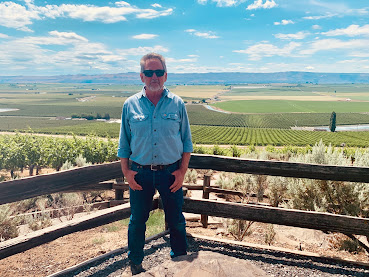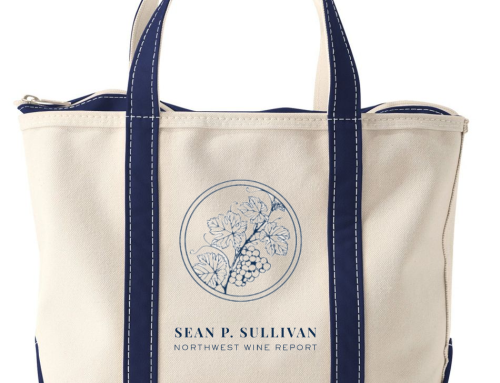On Thursday, July 7th, I took a day trip out to the Royal Slope. Though grapes have been grown in the area since the 1980s, Royal Slope only recently received appellation status, becoming Washington’s 15th federally approved growing region in 2020. In a sign of Washington’s fast moving times, the state now has 20 approved appellations, the most recent of which was Rocky Reach in June. Others are currently proposed.
Visiting Royal Slope, two things are immediately apparent. The first is where it gets its name. Legend has it that a pair of Scotsmen climbed the Saddle Mountains and remarked on the slope’s majesty, giving the area its moniker. The same pronouncement surely holds true today, with the broad slope providing a sense of majesty.
The second is how extensively planted the area is. Royal Slope grows just about everything. There are vineyards, orchards, row crops, and circle crops as far as the eye can see. All of this is made possible by irrigation in this otherwise arid region (Royal Slope receives an average of 6 to 8 inches of precipitation annually, the same as the larger Columbia Valley of which it is a sub-appellation). On this day, my wife and I almost had a sense that we were alone, with few other cars or even people in sight, save the occasional agricultural worker.
Our first stop of the day was at Stillwater Creek Vineyard to visit with vineyard manager Ed Kelly, pictured here. Kelly began a long and distinguished career grapegrowing in 1982 at Mount Veeder Winery. After two decades farming top level sites in California, Kelly moved to Washington with the intent to retire. However, life always has other plans. In 2011, he joined the Stillwater Creek team as vineyard manager. Kelly says he still intends to retire in the next few years but also gives every indication of someone who will stay involved in farming long after that.
“This is the most unique AVA I’ve ever worked in,” Kelly says of Royal Slope. “I think it produces more great vintages than anywhere in the world.”
Just looking at Royal Slope, one can see its tremendous physical advantages: a long, broad, generally south-facing slope; a range of elevations and aspects; and proximity to the Columbia River.
Stillwater itself is approximately 230 planted acres and sources fruit to about 40 wineries, most prominently Novelty Hill, where the vineyard’s fruit makes up the majority of production. Mike Januik, founder of Januik Winery in Woodinville and winemaker at Novelty Hill, worked with the Alberg family to plant Stillwater in 2000.
Kelly has focused much of his career on building soil structure at his sites, and so he has at Stillwater. “Better soil structure leads to better wines,” he says.
2022 has thus far been a cool year relative to the last 10. It was shocking to see just how far behind fruit development was from recent years, with clusters looking more like mid-June than the end of the first week of July (see image of Cabernet Sauvignon). Kelly estimates Stillwater is three weeks behind recent years – substantial but not anything that can’t be made up over the course of the growing season.
From Stillwater, my wife and I continued on to Solaksen Vineyard to meet with Alex Stewart (right) and Jesse Schmidt, two thirds of the new winemaking team at Matthews Winery. Hal Iverson makes up third of the trio. Matthews receives about 35% of its fruit from Royal Slope.
“Foremost, the intention of planning the vineyard: the high elevation, off-axis to which it is planted, vine density, and the diversity of clones per varietal,” he says “Add in the attention to each vine by the stellar crew there, and you have the recipe for some outstanding fruit.”
Like many esteemed vineyards in eastern Washington, Stoneridge is unassuming. It’s closer to the Saddle Mountains and is clearly a considerably warmer site than previous stops based on fruit development. The soils are sandy with fractured basalt. It almost looks like you’re at the beach.
We finished up the day making a side trip outside of the Royal Slope appellation to Conner Lee Vineyard. In my mind, Conner Lee is now the most highly regarded Columbia Valley vineyard that does not sit within one of the nested appellations. Perhaps in time, this area too will receive its own appellation status.
Conner-Lee has made its mark over the years with thrilling Chardonnays from Buty (which sadly closed its doors earlier this year), Bookwalter, Gorman, Sightglass, Valo, and others. The site was established in 1980 by Dick and Louise Owings under the direction of Dr. Walter Clore, recognized by the state as the “father of the Washington wine industry.” Conner Lee receives its name from Rhoady Lee and Bill Conner, who joined as partners in the vineyard. The vineyard was purchased by Josh Lawrence and Tom Merkle in 2019.
Conner Lee sits at an elevation of 1,085 feet to 1,164 feet with loamy fine sand and very fine sandy loam. Bottom line to non-soil scientists: lots and lots of sand.
There are 12 varieties planted at Conner Lee, including the increasingly seldom seen Chenin Blanc and the almost never seen Muscadelle. The site is 150 acres, with the Matthews team sourcing Chardonnay, Merlot, Cabernet Franc, and Pinot Noir. Note how much further along its fruit is in the picture than sites in the Royal Slope, even though Connor Lee is considered a cooler site (however, this is Pinot Noir).
Finally, it was time for the drive home, appreciating the occasional streams that along with irrigation, bring agriculture to these areas.





%20and%20Jesse%20Schmidt%20Matthews%20Winery.jpg)







Leave A Comment